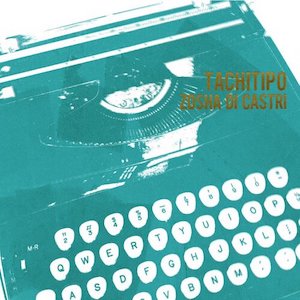
Zosha Di Castri, a 35-year-old Canadian composer now living and teaching in New York City, recently put out her first CD, an ear-challenging compendium of compositions from the last decade gathered under the title of the album’s centerpiece, Tachitipo (New Focus). It’s almost a resumé of sorts, best absorbed one piece at a time.
 Since I’m sure you’re wondering, Tachitipo is the name of an 1823-vintage typewriter model. Di Castri is not the first to call attention to the humble typewriter — as anyone who has loved Leroy Anderson’s uproarious little 1953 concerto for typewriter and orchestra, The Typewriter, would know. But her homage is a more elaborate, 24-minute parable that is, in her words, “a reflection on writing and the machines we use to execute our ideas,” using that now-obsolete yet newly-collectible typewriter “to build a syntax of sounds.”
Since I’m sure you’re wondering, Tachitipo is the name of an 1823-vintage typewriter model. Di Castri is not the first to call attention to the humble typewriter — as anyone who has loved Leroy Anderson’s uproarious little 1953 concerto for typewriter and orchestra, The Typewriter, would know. But her homage is a more elaborate, 24-minute parable that is, in her words, “a reflection on writing and the machines we use to execute our ideas,” using that now-obsolete yet newly-collectible typewriter “to build a syntax of sounds.”
After the scratching of gourds at the beginning, the two pianos pound (one of them apparently detuned), the electronics ping and burble, and a mad clockwork machine full of mechanistic momentum emerges in fits and starts. What sounds like a real typewriter pecks away in the percussion section near the end, and it’s here that something close to the whimsy and humor of Anderson’s miniature can be felt.
Elsewhere on the disc, The Animal After Whom Other Animals Are Named is a wild workout full of extended vocal techniques for six voices and electronics. Cortège for 13 instruments is part-dirge, part-whirling circus, with both elements alternating sometimes within seconds of each other. The fearless JACK Quartet shows up for Di Castri’s Quartet No. 1, where she plays with simulated backwards sounds, glissandos, microtones, and as many other experimental techniques as she can cram into ten minutes. Dux finds pianist Julia Den Boer exploring the extreme ends of technique all over the keyboard, and the quintet La forma dello spazio (performed by members of International Contemporary Ensemble) does similar things, but not without humor.
A “bonus track,” how many bodies have we to pass through, is not on the CD itself; you have to go online to access it as a video. But the extra effort is worth it because the piece benefits from seeing the solo percussionist/co-composer Diego Espinosa Cruz Gonzales going about his craft. Gonzales demonstrates a deft and dexterous finger technique on maracas from Venezuela, Brazil, and Mexico, two South Indian kanjiras and a Brazilian tamborum tied together as a triple-hand-drum set, Chinese opera gongs, and a Korean jing. He even uses a hair lift comb as a mallet. There is circular scratching of the drumheads near the start, and a climactic episode that goes all-out bonkers before matters end very, very quietly.
The imaginatively experimental bent of Di Castri’s music is complemented by nifty packaging; a cover of thin, presumably recyclable cardboard folds out to reveal a leaflet that itself folds out to reveal the program notes, with the disc snugly lodged underneath. Such are the joys of physical product that streaming cannot hope to capture.




